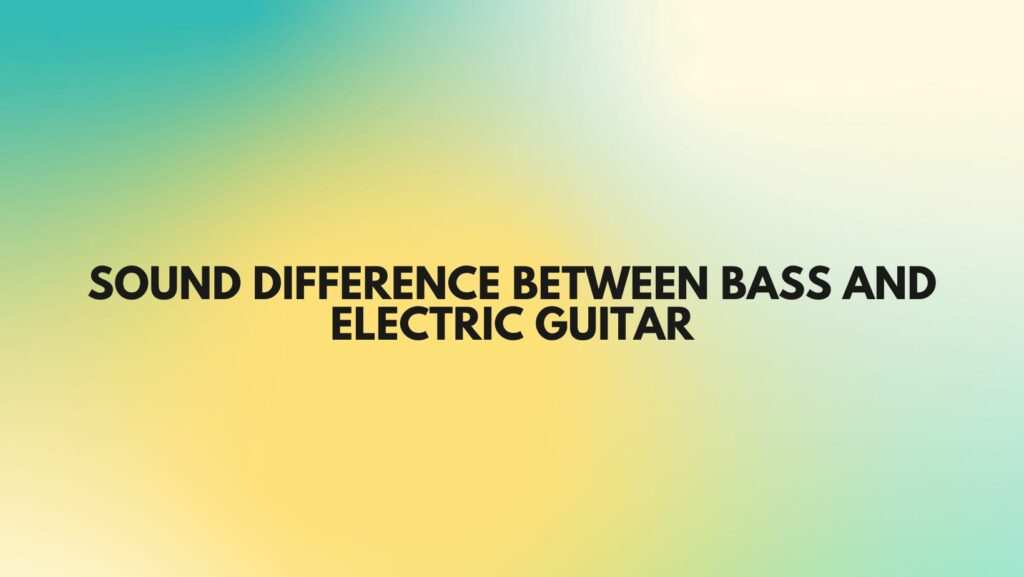Music is a universal language, and the choice of instruments used to create it significantly impacts the overall sonic landscape. Two prominent instruments in the world of contemporary music are the bass guitar and the electric guitar. While both are string instruments and share similarities in their construction, they produce distinct sounds that serve different roles within a band or ensemble. In this comprehensive article, we will delve into the sound differences between the bass and electric guitar, considering their construction, playing techniques, and sonic characteristics.
Construction and Anatomy
Before we can understand the sound differences between these two instruments, it’s important to examine their construction and anatomy:
Bass Guitar:
The bass guitar, commonly referred to as the “bass,” typically features four strings (though five and six-string basses are also common). Its longer neck and larger body contribute to its deep, resonant sound. The strings on a bass are thicker and longer than those on an electric guitar, requiring greater tension to produce the lower frequencies. Bass strings are tuned to the lower octaves, usually in standard tuning (E, A, D, G), and can be plucked or slapped to create a solid and rhythmic foundation for a band.
Electric Guitar:
Electric guitars usually have six strings, each with a different thickness, allowing for a wide range of frequencies. These strings are tuned to standard E-A-D-G-B-E, with the high E being the thinnest and the low E the thickest. The guitar’s construction includes a shorter neck and a smaller body compared to the bass. Electric guitars have magnetic pickups under the strings, which convert string vibrations into electrical signals. These signals are then amplified and processed to create a broad spectrum of sounds, making the electric guitar incredibly versatile.
Playing Techniques
Playing techniques also play a significant role in shaping the distinct sounds of the bass and electric guitar:
Bass Guitar:
- Picking and Plucking: Bassists can use either their fingers or a plectrum (pick) to strike the strings. Fingerstyle playing produces a warm, round sound, while picking can yield a sharper, more defined attack.
- Slap and Pop: Unique to the bass guitar, these techniques involve slapping the strings against the fretboard and popping them to create percussive and funky tones.
Electric Guitar:
- Strumming and Picking: Guitarists often use a plectrum to strum or pick the strings. The choice of picking style, such as alternate picking, downstrokes, or upstrokes, significantly influences the attack and tone.
- Bending and Vibrato: Electric guitarists can bend the strings to produce pitch variations and apply vibrato techniques to create expressive and emotive sounds.
- Hammer-ons and Pull-offs: These techniques involve using the fretting hand to produce legato phrasing, allowing for smooth transitions between notes.
Sonic Characteristics
Now, let’s explore the distinct sonic characteristics of the bass and electric guitar:
Bass Guitar:
- Low Frequencies: The bass guitar is responsible for providing the deep, foundational frequencies in a band. It produces powerful low-end tones that are felt as much as they are heard.
- Rhythmic Foundation: The bass guitar’s role in most musical genres is to establish and maintain the rhythmic groove. Its sound anchors the music, allowing other instruments to build upon it.
- Warm and Sustained: The bass’s sound is characterized by warmth and sustain. The notes produced by a bass guitar are rich and full, creating a solid backbone for the music.
Electric Guitar:
- Versatility: Electric guitars are renowned for their versatility. They can produce a wide range of tones, from clean and clear to distorted and aggressive, depending on the playing style and the use of effects and amplification.
- Melodic and Expressive: Electric guitars are often used for melody and lead lines, allowing for expressive and emotional playing. The ability to bend notes and use vibrato adds a vocal quality to the sound.
- Dynamic Range: Electric guitars offer a broad dynamic range, from delicate fingerpicking to powerful, overdriven chords. The sound can be shaped by the player’s technique, pickup selection, and amplifier settings.
Conclusion
In summary, the bass guitar and electric guitar are two distinct instruments, each with its own unique sound and role in the world of music. The bass guitar provides a deep, resonant foundation for a band, focusing on rhythm and groove, while the electric guitar is a versatile instrument capable of producing a wide array of tones, often used for melody and lead playing. These instruments complement each other, working together to create the rich and diverse soundscapes we hear in various music genres. Understanding the sound differences between the bass and electric guitar is crucial for musicians and enthusiasts looking to craft their sonic identity and contribute effectively to musical collaborations.


